1. Overview
The Spiro Dashboard is a WhatsApp solution designed to automate and enhance customer interactions. It provides real-time metrics, user input tracking, and geographic targeting to streamline engagement and data management.

Figure 1: Spiro Dashboard interface showing key metrics and controls
Key Features:
- 24/7 AI-driven customer support via WhatsApp
- Real-time lead and conversation tracking
- Customizable user inputs for detailed profiling
- Consent management for data privacy compliance
- Geographic focus on East African markets
Powered by: Ged-I engine
2. Dashboard Components
2.1 Metrics Overview
The dashboard displays real-time KPIs in a clean, glanceable format:
Leads Today
New leads captured in current day
Example: 0
Total Leads
Cumulative leads over time
Example: 0
Conversations
Active customer interactions
Example: 0
Shared to Atlas
Data synced with Atlas system
Example: 0
2.2 Geographic Targeting
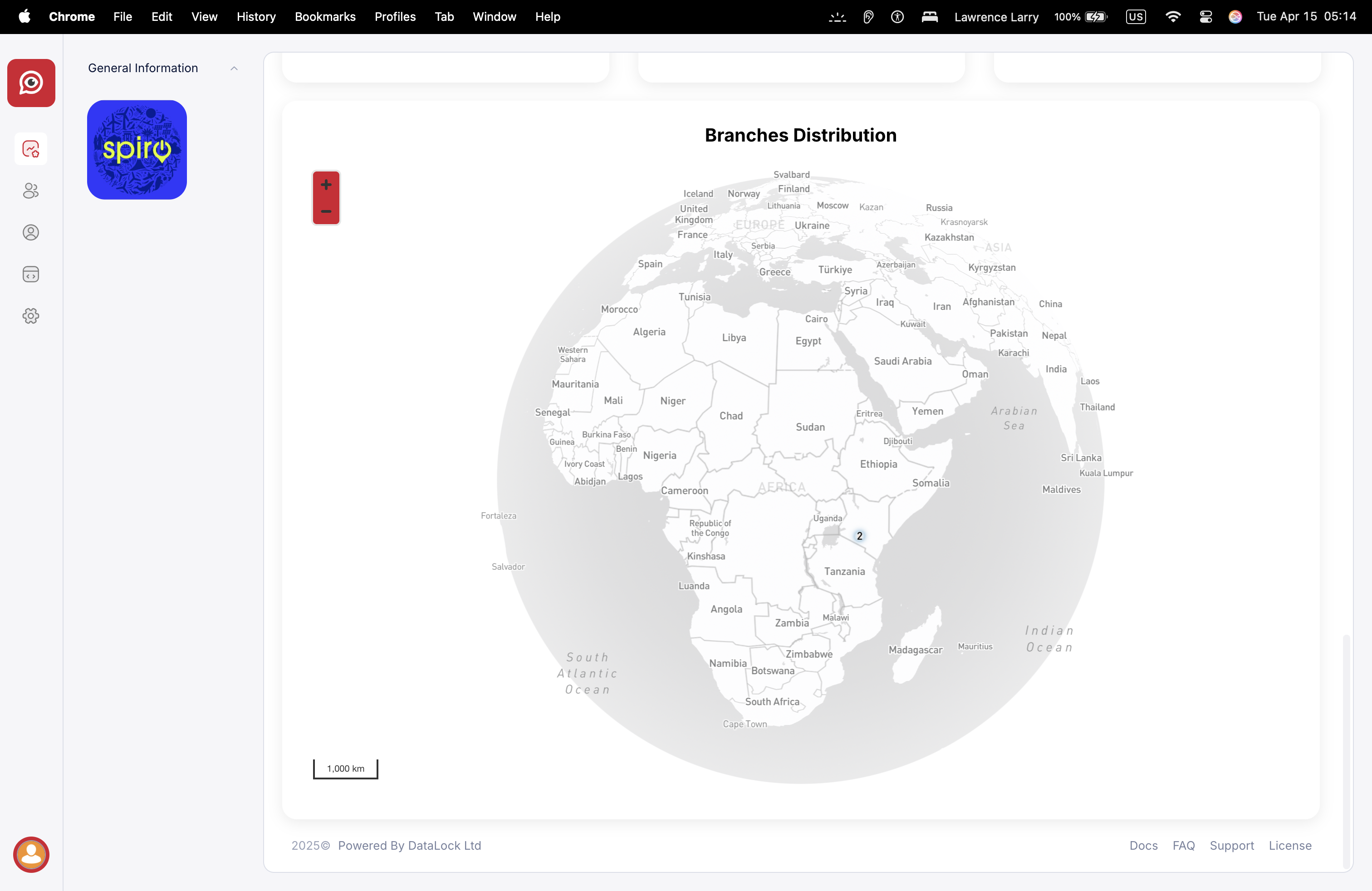
Users can filter and analyze data by region:
- Kenya
- Tanzania
- Uganda
- Awards (special category)
The checkbox interface allows for multi-select filtering of customer data.
2.3 User Input Tracking
The system captures 57 distinct data fields including:
- Demographics (Gender, Salutation)
- Identity (National ID, Account Name)
- Financial (KDA Account Number)
3. Leads Import Module
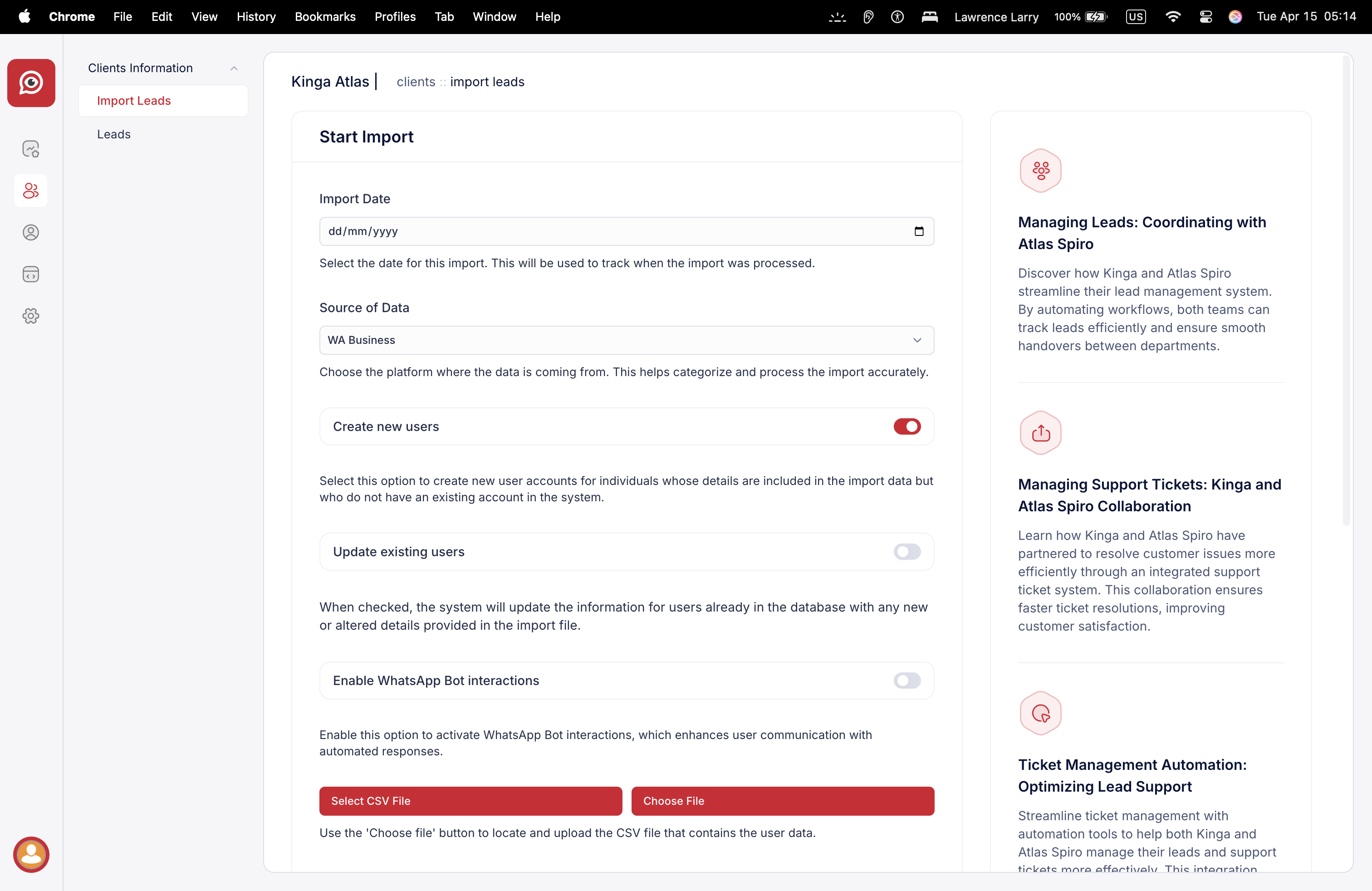
Key Functionality
- Date-Stamped Imports: Track processing timeline with import date selection
- Data Source Identification: Categorize imports by source (e.g., WA Business)
- User Management:
- Create new accounts for unrecognized leads
- Update existing user records
- WhatsApp Integration: Instant activation of bot interactions for imported leads
- CSV File Processing: Bulk upload capability for lead data
Collaboration Features
The system enables seamless coordination between Kings and Atlas Spiro for:
- Lead Management: Automated workflow routing between teams
- Support Tickets: Integrated resolution system with performance tracking
4. Profile Management
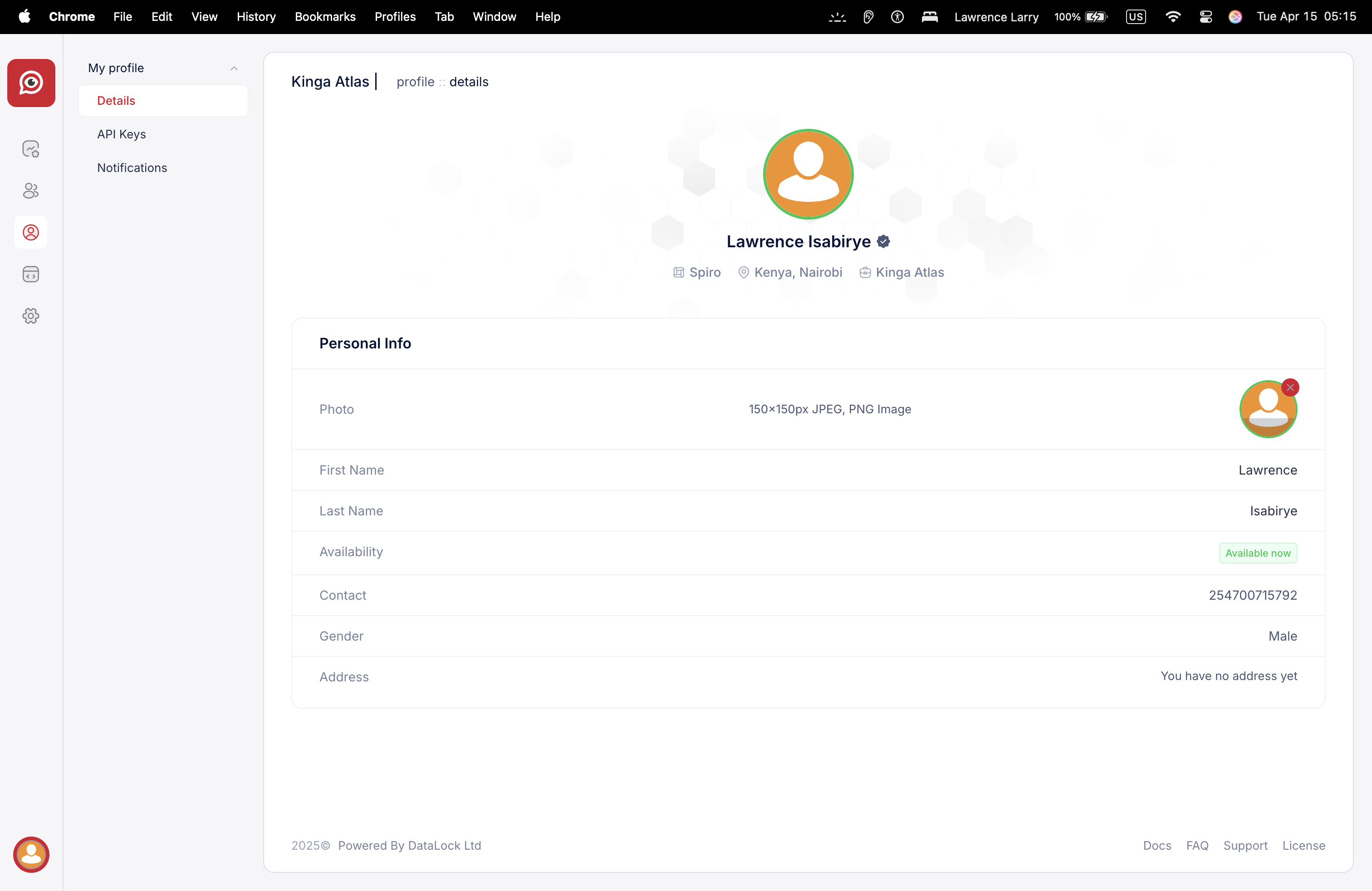
User Profile Components
| Section | Description |
|---|---|
| Profile Header | Displays name, affiliation badges (Spiro/Kings Atlas), and location |
| Photo Upload | Supports 150×150px JPG/PNG images |
| Personal Info | Structured fields including contact, availability status, and demographic data |
Example Profile Data
Name: Lawrence Isabirye
Contact: 254700715792
Affiliation: Active in Kenya/Nairobi region
5. Customer Type Configuration
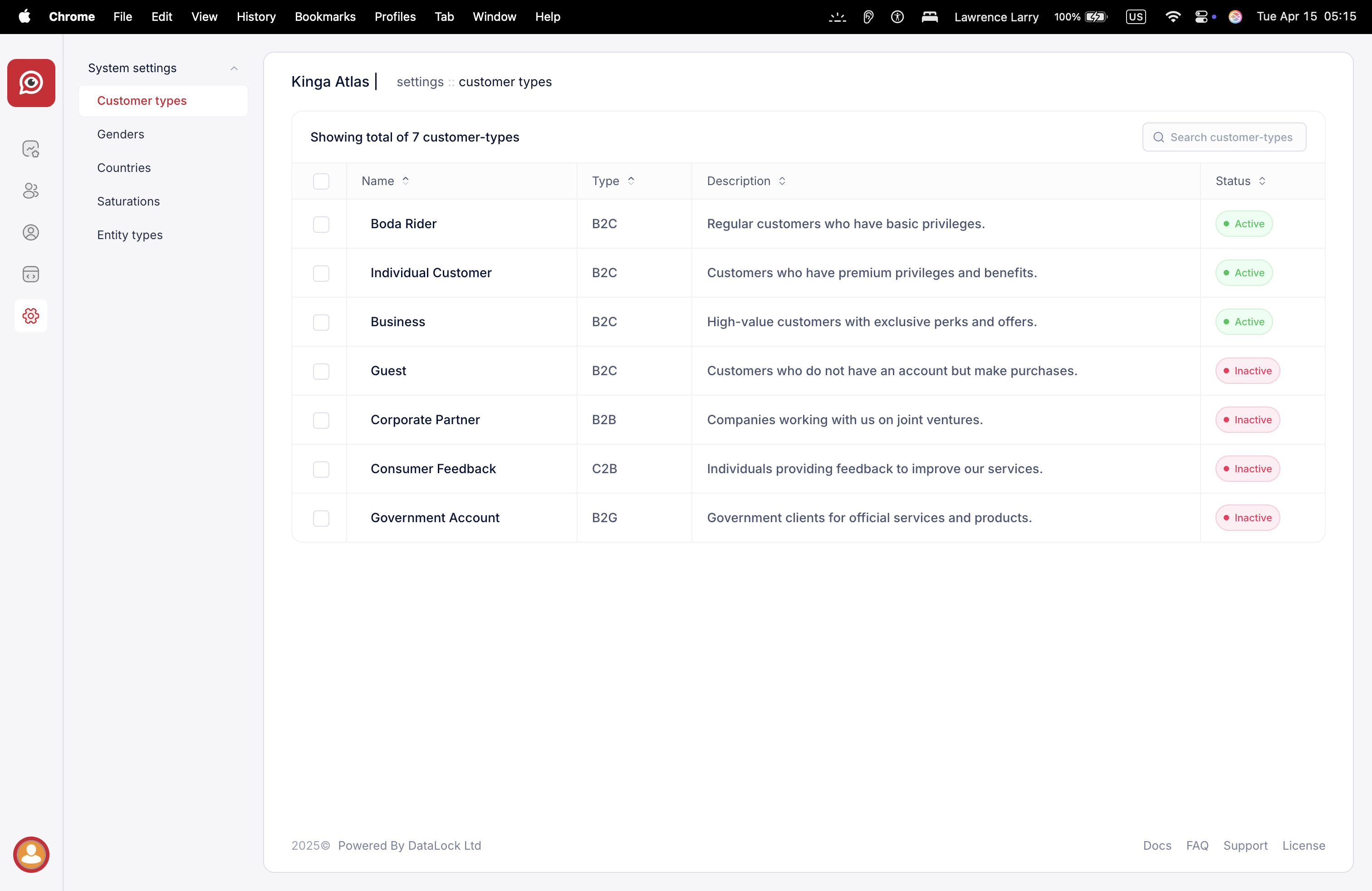
Type Classification
| Type | Category |
|---|---|
| Boda Rider | B2C |
| Corporate Partner | B2B |
| Government Account | B2G |
Status Management
- Active/Inactive toggle for each type
- Search functionality for quick filtering
- Detailed descriptions of privileges
Business Logic
The system distinguishes between:
- Regular Customers: Basic purchase privileges
- Premium Accounts: Enhanced benefits and offers
- Strategic Partners: Custom workflows for B2B/G relationships
6. Bot Input Configuration
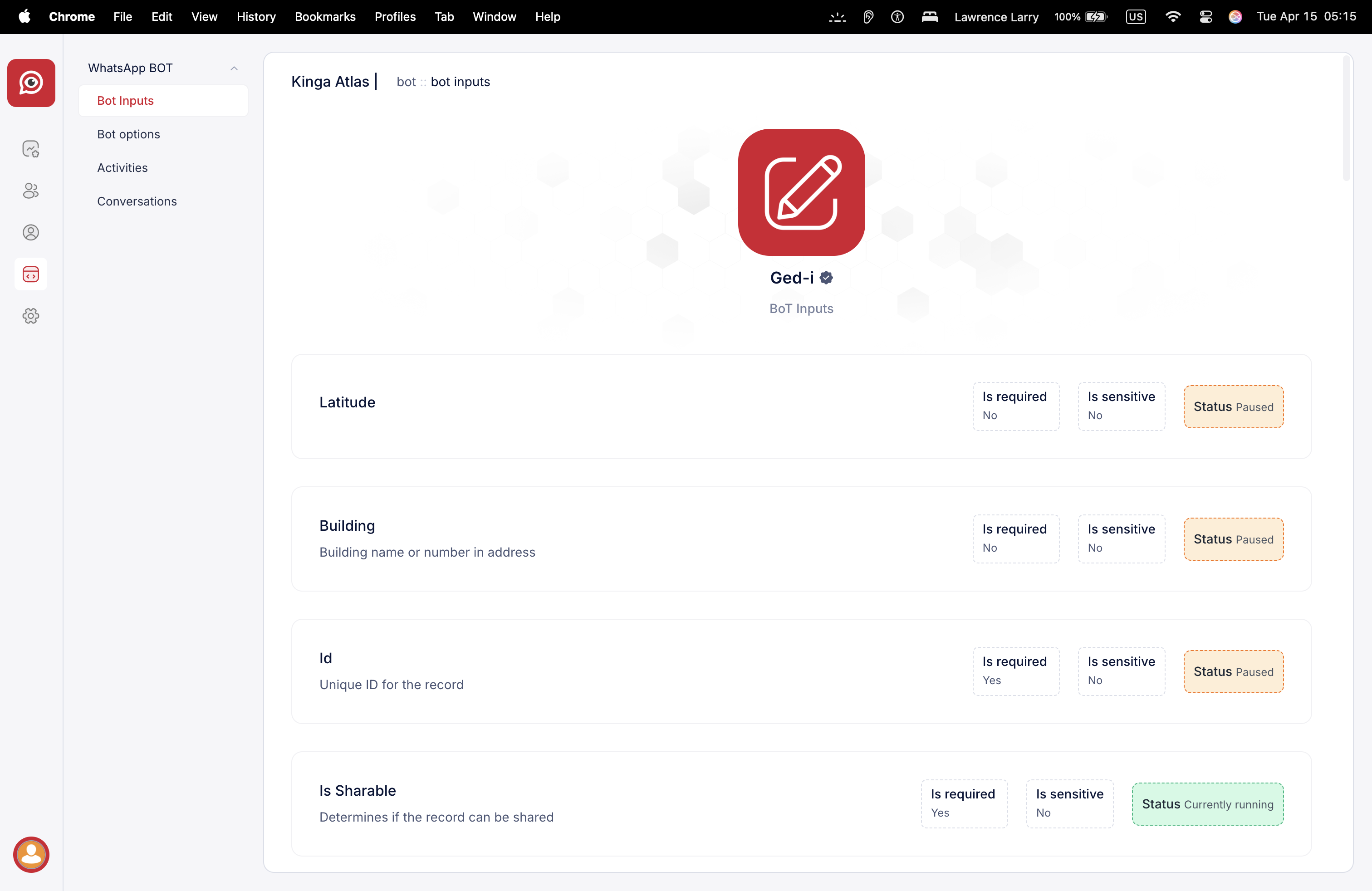
Field Management
| Attribute | Configuration Options |
|---|---|
| Latitude (Example Field) |
|
| Unique ID | System-generated identifier |
| Shareability | Granular control over data sharing permissions |
Operational States
Fields can be set to:
- Paused: Temporarily inactive
- Running: Actively collecting data
- Sensitive: Additional security protocols
Spiro WhatsApp BoT API Documentation v1.2.0
This comprehensive documentation provides technical details for integrating with the Spiro WhatsApp conversational platform. The API enables dynamic form handling, multi-step workflows, and intelligent response generation through WhatsApp.
System Architecture
The Spiro WhatsApp BoT employs a modular, event-driven architecture designed for high availability and scalability:
┌───────────────────────────────────────────────────────────────────────────────┐
│ WhatsApp Message │
└───────────────────────────────┬───────────────────────────────────────────────┘
│
▼
┌───────────────────────────────────────────────────────────────────────────────┐
│ API Endpoint │
│ (Request Validation & Routing) │
└───────────────────────────────┬───────────────────────────────────────────────┘
│
▼
┌───────────────────────────────────────────────────────────────────────────────┐
│ State Manager │
│ (Determines current conversation context and next required actions) │
└───────────────────────────────┬───────────────┬───────────────────────────────┘
│ │
▼ ▼
┌───────────────────────┐ ┌───────────────────────┐ ┌───────────────────────────┐
│ Conversation Init │ │ Form Processor │ │ Command Handler │
│ (New interactions) │ │ (Field validation & │ │ (Special functions) │
│ │ │ data collection) │ │ │
└───────────┬───────────┘ └───────────┬───────────┘ └───────────┬───────────────┘
│ │ │
└─────────────┬───────────┴─────────────────────────┘
│
▼
┌───────────────────────────────────────────────────────────────────────────────┐
│ Response Engine │
│ (Generates context-aware responses based on business logic) │
└───────────────────────────────┬───────────────────────────────────────────────┘
│
▼
┌───────────────────────────────────────────────────────────────────────────────┐
│ WhatsApp Integration │
│ (Message delivery with read receipts and status tracking) │
└───────────────────────────────────────────────────────────────────────────────┘
Core Components
State Management
Maintains conversation context and tracks progress through multi-step workflows with configurable timeouts.
Dynamic Forms
Supports conditional fields, branching logic, and dynamic validation rules based on previous responses.
Validation Engine
Implements comprehensive input sanitization and validation with customizable error messages.
Response Builder
Generates context-aware responses with smart formatting for optimal WhatsApp display.
Integration Layer
Handles all WhatsApp Business API communications with automatic retry logic.
Analytics
Tracks conversation metrics, completion rates, and drop-off points for optimization.
API Endpoints
The system provides a single unified endpoint for all WhatsApp interactions:
Request Specifications
{
"api_key": "your_api_key_here",
"timestamp": "2023-06-15T14:30:00Z",
"messages": [
{
"message_id": "wamid.ABGSV...9JKL=",
"from": "254700715792",
"timestamp": "2023-06-15T14:29:58Z",
"type": "text",
"content": "Spiro help",
"context": {
"replied_to": null,
"forwarded": false
},
"profile": {
"name": "John Doe",
"language": "en"
}
}
]
}
Response Specifications
{
"status": "success",
"timestamp": "2023-06-15T14:30:02Z",
"request_id": "req_7a3b9c8d5e6f",
"data": {
"messages": [
{
"to": "254700715792",
"type": "text",
"content": "Hi John! How may I help you today?",
"options": [
{"id": 1, "text": "Account Support"},
{"id": 2, "text": "Product Inquiry"},
{"id": 3, "text": "Technical Help"}
],
"metadata": {
"session_id": "sess_abc123",
"step": "main_menu"
}
}
]
}
}
Endpoint Behavior Matrix
| User Input | System Action | Response Pattern | State Transition |
|---|---|---|---|
| "Spiro" or "Hi Spiro" | Initializes new session, clears previous state | Main menu with available options | initial → menu |
| Menu option (1-9) | Loads corresponding workflow | First question in selected flow | menu → form |
| Valid form input | Stores response, progresses to next field | Next question or confirmation | form → form (or complete) |
| "0" (back command) | Returns to previous question | Repeats previous question | form → form (previous) |
| Invalid input | Maintains current position | Error message with requirements | form → form (same) |
Authentication
Secure API access is enforced through JWT (JSON Web Tokens) with the following requirements:
Authentication: Bearer eyJhbGciOiJIUzI1NiIsInR5cCI6IkpXVCJ9.eyJzdWIiOiIxMjM0NTY3ODkwIiwibmFtZSI6IkpvaG4gRG9lIiwiaWF0IjoxNTE2MjM5MDIyfQ.SflKxwRJSMeKKF2QT4fwpMeJf36POk6yJV_adQssw5c
Authentication Flow
1. Client requests API key from admin portal
2. System generates JWT with:
- API key identifier
- Issued timestamp
- Expiration (default 90 days)
3. Client includes token in Authorization header
4. Server validates:
- Signature
- Expiration
- API key permissions
5. Access granted or denied with appropriate status code
Data Storage
The system employs a structured approach to data persistence with multiple storage tiers:
Data Lifecycle Management
┌───────────────────────┐ ┌───────────────────────┐ ┌───────────────────────┐
│ │ │ │ │ │
│ Active Sessions │ → │ Completed Forms │ → │ Archived Data │
│ (Real-time access) │ │ (30-day retention) │ │ (1-year retention) │
│ │ │ │ │ │
└───────────────────────┘ └───────────────────────┘ └───────────────────────┘
Data Structure Specifications
| Component | Fields | Description | Encryption |
|---|---|---|---|
| User Profile | phone, name, locale, preferences | Basic user information | AES-256 |
| Session State | current_flow, step, last_activity | Conversation progress | None |
| Form Data | responses, timestamps, metadata | User-provided information | AES-256 |
| Message Logs | content, direction, status | Communication audit trail | None |
Input Validation
The validation engine supports multiple validation types with customizable rules and error messages:
Validation Type Matrix
| Type | Description | Parameters | Error Example |
|---|---|---|---|
text |
General text input | min_len, max_len, regex | "Name must be 2-100 characters" |
numeric |
Number validation | min, max, decimal | "Please enter a number between 1-100" |
email |
Email format | domain_whitelist | "Enter a valid email address" |
phone |
Phone number | country_code | "Include country code (e.g. 254...)" |
selection |
Predefined options | options[], multi_select | "Choose from available options" |
Validation Process Flow
┌───────────────────────┐ ┌───────────────────────┐ ┌───────────────────────┐
│ │ │ │ │ │
│ Receive User Input │ → │ Apply Sanitization │ → │ Validate Against │
│ │ │ Rules │ │ Criteria │
└───────────┬───────────┘ └───────────┬───────────┘ └───────────┬───────────┘
│ │ │
▼ ▼ ▼
┌───────────────────────┐ ┌───────────────────────┐ ┌───────────────────────┐
│ │ │ │ │ │
│ Store Raw Input │ │ Transform Cleaned │ │ Return Validation │
│ for Audit │ │ Value │ │ Result │
│ │ │ │ │ │
└───────────────────────┘ └───────────────────────┘ └───────────────────────┘
Message Flow Handling
The conversation engine manages complex workflows with configurable rules:
State Transition Diagram
┌───────────────┐ "start" ┌─────────────────┐ select ┌─────────────────┐
│ │─────────────▶│ │───────────▶│ │
│ Initial │ │ Main Menu │ │ Form Flow │
│ │◁─────────────│ │◁───────────│ │
└───────────────┘ "reset" └────────┬────────┘ "back" └────────┬────────┘
│ │
│ complete │
▼ │
┌─────────────────┐ invalid │
│ │◁──────────────────────┘
│ Completion │
│ │
└─────────────────┘
Flow Control Features
Conditional Branching
Show different questions based on previous answers using if-then-else logic.
Dynamic Field Order
Rearrange question sequence based on real-time responses.
Multi-Page Forms
Split long forms across multiple messages with progress tracking.
Session Recovery
Resume interrupted conversations from last completed step.
Implementation Examples
Basic Integration
// Example: Handling incoming message
function handleMessage(message) {
// Verify authentication
if (!validateAuth(message.api_key)) {
return errorResponse(401, "Invalid API key");
}
// Process each message
message.messages.forEach(msg => {
// Get current conversation state
const state = getConversationState(msg.from);
// Route to appropriate handler
switch(state.step) {
case 'initial':
showMainMenu(msg.from);
break;
case 'menu':
handleMenuSelection(msg.from, msg.content);
break;
case 'form':
processFormInput(msg.from, msg.content, state);
break;
}
});
return successResponse();
}
Form Processing Logic
// Example: Form input handler
function processFormInput(userId, input, state) {
// Handle navigation commands
if (input === '0') {
return goBackToPreviousQuestion(userId, state);
}
// Get current field validation rules
const field = state.current_field;
const rules = getValidationRules(field);
// Validate input
const validation = validateInput(input, rules);
if (!validation.valid) {
return sendValidationError(userId, field, validation.message);
}
// Store valid response
saveResponse(userId, field, validation.cleanValue);
// Determine next step
const nextStep = calculateNextStep(state);
if (nextStep) {
sendQuestion(userId, nextStep);
updateState(userId, { current_field: nextStep });
} else {
completeForm(userId);
updateState(userId, { step: 'complete' });
}
}
Error Handling
The system provides comprehensive error handling with detailed feedback:
Error Response Structure
{
"status": "error",
"timestamp": "2023-06-15T14:35:12Z",
"error": {
"code": "VALIDATION_FAILED",
"message": "Invalid email format",
"details": {
"field": "email",
"requirements": "Must be a valid email address",
"provided": "user@example"
},
"request_id": "req_123456789"
}
}
Common Error Codes
| Code | HTTP Status | Description | Resolution |
|---|---|---|---|
| AUTH_REQUIRED | 401 | Missing or invalid API key | Provide valid authentication |
| VALIDATION_FAILED | 400 | Input validation error | Correct input format |
| RATE_LIMITED | 429 | Too many requests | Wait or increase quota |
| SESSION_EXPIRED | 410 | Conversation timeout | Restart conversation |
Rate Limiting
The API implements tiered rate limiting to ensure fair usage:
┌───────────────────────┐ ┌───────────────────────┐ ┌───────────────────────┐
│ │ │ │ │ │
│ User-Level Limits │ → │ Application-Level │ → │ Global Limits │
│ (30/min per user) │ │ (100/min) │ │ (5,000/request) │
│ │ │ │ │ │
└───────────────────────┘ └───────────────────────┘ └───────────────────────┘
Rate Limit Headers
X-RateLimit-Limit: 100 X-RateLimit-Remaining: 42 X-RateLimit-Reset: 1686844800 Retry-After: 60
Security Considerations
The system incorporates multiple security layers to protect data and ensure privacy:
Security Architecture
┌───────────────────────┐ ┌───────────────────────┐ ┌───────────────────────┐
│ │ │ │ │ │
│ Transport Security │ → │ Data Encryption │ → │ Access Control │
│ (TLS 1.2+) │ │ (AES-256) │ │ (RBAC) │
│ │ │ │ │ │
└───────────┬───────────┘ └───────────┬───────────┘ └───────────┬───────────┘
│ │ │
▼ ▼ ▼
┌───────────────────────┐ ┌───────────────────────┐ ┌───────────────────────┐
│ │ │ │ │ │
│ Input Sanitization │ → │ Audit Logging │ → │ Regular Pentests │
│ │ │ │ │ │
└───────────────────────┘ └───────────────────────┘ └───────────────────────┘
Security Best Practices
- Always use HTTPS - All API requests must use TLS encryption
- Rotate keys quarterly - Regular key rotation limits exposure
- Principle of least privilege - Grant minimum necessary permissions
- Validate all inputs - Never trust client-side validation
- Monitor for anomalies - Implement real-time alerting
Implementation Best Practices
Follow these guidelines for optimal integration:
Client-Side Recommendations
Exponential Backoff
Implement with jitter for rate limit handling to avoid thundering herd problems.
Connection Pooling
Maintain persistent connections to reduce latency and improve throughput.
Request Batching
Combine multiple operations in single requests where possible.
Idempotency Keys
Use for critical operations to enable safe retries.
Performance Optimization
| Technique | Implementation | Benefit |
|---|---|---|
| Caching | Cache frequent responses with appropriate TTLs | Reduces API calls and latency |
| Compression | Enable gzip for large payloads | Reduces bandwidth usage |
| Parallelism | Process independent requests concurrently | Improves throughput |
| Pagination | Use cursor-based pagination for large datasets | Reduces memory pressure |
- Implement proper monitoring and alerting
- Document your integration architecture
- Establish rollback procedures
- Test under load before deployment
- Schedule regular security reviews
